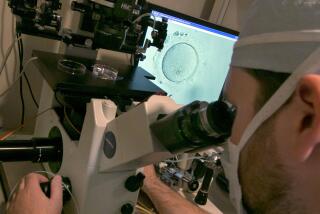Octuplets rattle fertility experts
- Share via
Even as the birth of octuplets at Kaiser Permanente Bellflower Medical Center drew attention and applause from around the country, questions arose Tuesday about whether the mother’s doctors did enough to prevent such a risky pregnancy.
The chances that the eight babies born Monday were conceived naturally are infinitesimal, infertility specialists and doctors in maternal-fetal medicine say. Today’s reproductive experts have the tools and the know-how to avoid such high-risk pregnancies -- and often try desperately to do so.
“When we see something like this in the general fertility world, it gives us the heebie-jeebies,” said Michael Tucker, a clinical embryologist in Atlanta and a leading researcher in infertility treatment. Tucker added that in his opinion, “if a medical practitioner had anything to do with it, there’s some degree of inappropriate medical therapy there.”
The parents of the octuplets have not been identified, and Kaiser officials say they have not been authorized to release information to the public on how the babies were conceived.
Doctors reported Tuesday that the eight babies, six boys and two girls, are doing fine. The babies were delivered Monday by cesarean section 9 1/2 weeks early and ranged in weight from 1 pound, 8 ounces to 3 pounds, 4 ounces.
“The babies had a very good night,” said Dr. Mandhir Gupta, a neonatologist at Kaiser Permanente Bellflower Medical Center. The babies are stable and the two who were receiving help breathing had their breathing tubes removed Tuesday morning. They began feeding as well.
“They’re doing amazingly well,” Gupta said.
Despite that hopeful report, however, higher-order multiple births (defined as three or more babies born together) are dangerous for babies and the mother. Infants born prematurely face the risk of breathing problems and brain injuries that may cause permanent disability. Problems in premature babies, including learning disabilities or cognitive delays, are often not apparent until years after their births.
The American Society for Reproductive Medicine and the American College of Obstetricians and Gynecologists say “doctors should be making efforts to curb these higher-order multiple gestations,” said Dr. Geeta Swamy, an assistant professor of obstetrics and gynecology at Duke University. “But it really is still up to the individual physician. There aren’t any laws or legal ramifications to it.”
The babies could have been conceived through in vitro fertilization, in which eggs and sperm are combined in the lab and a specified number of the healthiest-looking embryos are transferred to the uterus. That scenario seems unlikely because fertility doctors are asked to adhere to strict guidelines that limit the number of embryos transferred. As a result, higher-order multiple births resulting from in vitro fertilization are uncommon.
A more likely scenario is that the mother of the octuplets received infertility drugs in a procedure called controlled ovarian hyperstimulation. The treatment, which is typically used to achieve pregnancy in women who do not ovulate, stimulates the ovaries to produce a number of eggs. As the eggs near maturity, the patient usually has artificial insemination.
An oral drug, clomiphene, can be used to stimulate the release of one or two mature eggs. But more powerful, injectable medications may produce eight to 10 mature eggs, said Dr. David Diaz, medical director of West Coast Fertility Centers in Orange County.
“That’s the most common way these higher-order multiples occur,” he said.
Some patients with infertility problems opt to try controlled ovarian hyperstimulation instead of in vitro fertilization because it is far less expensive -- about $2,000 to $3,000 instead of $10,000. Kaiser Permanente does not cover in vitro fertilization for its members. Although the octuplets were born in a Kaiser hospital, it’s not known whether the mother is a Kaiser member.
Ovarian stimulation is far less controllable than in vitro fertilization, Swamy said, “because you can’t control how many embryos you put back.”
Even so, doctors typically go to great lengths to monitor treatments involving infertility drugs, Diaz said. If tests show too many eggs have been stimulated, doctors often will not follow through with a second medication that releases the eggs. They can also drain some of the follicles to reduce the number of eggs released.
If patients choose to proceed with the treatment -- even facing the potential of a large number of eggs being released -- they can later abort some of the embryos if a higher-order pregnancy occurs. Many patients dislike this practice, called selective reduction, said Dr. Harold Henry, director of maternal-fetal medicine at Kaiser Permanente. Some have religious or ethical objections to aborting any of the fetuses; others don’t want to risk losing the entire pregnancy.
Infertility experts generally try to prevent multiple births because of the myriad potential health problems for mother and babies and because such births consume enormous financial resources for hospitals, health insurers and families.
Higher-order multiples are always born prematurely, often before 30 weeks gestation. Such babies are at risk of respiratory distress, infection and damage to their other organs, particularly the brain and gut. Premature infants have a higher rate of death in the first month of life than babies born full-term. Later, these babies are at higher risk for developmental problems and cerebral palsy.
“I hope they do well,” Swamy said. “But often in the first day or two you don’t see all the significant risks or complications that occur yet. You’re looking at an average stay in intensive care of one month to six months depending on how they do. They are obviously not going to be feeding and growing in the same rate or manner that a singleton can.”
Diaz added, “As the technology has evolved and we’ve had more success in the ability to develop embryos in the lab, we’ve become more careful and more conscientious that these births can occur.
“Most reproductive endocrinologists are very consistent in trying to avoid these kinds of pregnancies.”
--
jeff.gottlieb@latimes.com







